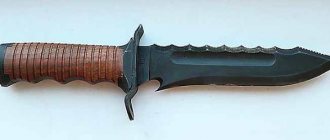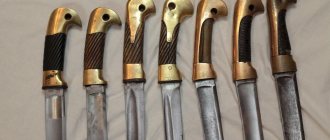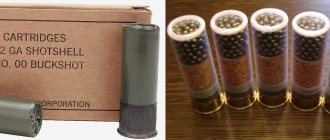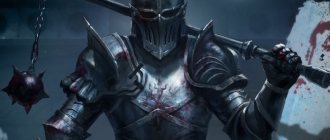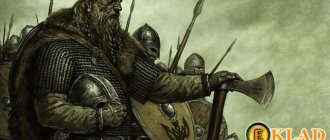History of origin
In general, the term saber is tightly linked to the Abkhaz-Adyghe word “sashkho”, which literally means “big knife”. The first examples of sabers date back to the 12th-13th centuries, and these were large combat knives, which, along with daggers, complemented the warrior’s weapons. The first literary mention of checkers dates back to 1625.
Gradually, as firearms developed, heavy armor began to leave weapon sets. Chain mail remained in service with the Circassians for the longest time. And the role of the checker as the main weapon began to increase until the saber completely disappeared from use. In the process of its evolution, the saber gradually became longer and more massive, the bend decreased, and the hilt became simpler.
In 1881, a military reform was carried out in the Russian Army, as a result of which, in the process of unifying edged weapons, the saber corps was adopted for the arsenal of cavalry units, as well as officer and engineering units. The saber remained in service with the hussars and lancers, as well as some units of the Life Guards. In addition, the saber became the authorized bladed weapon of the police and gendarmerie.
The blade of the so-called “Caucasian type” was chosen as the basis for the new model.
The arguments for replacing the saber with a saber were:
- A simplified fencing technique, so the Charter of 1889 mentioned only three blows delivered with a checker: horizontal, vertical and a thrust to the left. Consequently, the training of a cavalryman became simpler and cheaper.
- Due to the shift in balance in the blade, the saber was perfectly suited for delivering strong slashing blows.
- Simplified production technology relative to the saber, which also reduced material costs.
The checker was worn with the cutting edge up on the left side, which made it possible to deliver a powerful blow at lightning speed. Actually, fencing, like with sabers, with the help of checkers was practically excluded. The fight came down to delivering strong single blows with a horse collision. The ergonomics of the handle and the bend of the blade made piercing blows ineffective; due to the lack of a hilt, the fingers could easily slip onto the cutting edge.
The checker handle was held with 5 main grips:
- Normal, when all the fingers tightly covered the handle;
- Circassian, when the palm moves closer to the hilt, and the thumb and index fingers cover the hilt itself;
- Grip by the “jib”, the hand is lowered to the top of the handle, the jib is clamped at the base of the hand, which allows you to connect the hand to the blows;
- The European method is similar to a regular grip, only the thumb rests on the back of the handle;
- Reverse grip, thumb at the jib, little finger at the flint.
Structurally, the checker consists of the following elements:
- tip;
- Butt;
- Blade;
- Doly;
- Heel;
- Handle;
- Lanyard;
- Sheath;
- Scabbard clip;
- Garda.
The saber was constantly modernized throughout its use, and is the last bladed weapon that was massively used during the Great Patriotic War by cavalry units of the Red Army,
Distinctive features of the Cossack saber
The saber and the Cossack saber are very similar to each other. A distinctive feature of a checker is a wooden sheath, covered with leather, with one or two rings for sword belts on the convex side. This weapon was worn on a shoulder belt with the blade facing backwards. The saber was worn on the belt, with the blade forward.
Caucasian checkers had a two-edged, slightly curved blade with a combat end and a handle with a forked head. Such a hilt is considered a distinctive feature of a checker. Russian Cossack sabers differed from Caucasian ones in their scabbard and hilt. The first army samples looked more like sabers and were slightly more curved.
Characteristics
As a rule, the blade of a checker was made of high-carbon steel that underwent special heat treatment. Sometimes there are samples made of Damascus steel, but as a rule these are premium samples. Individually, officers of cavalry and Cossack units ordered sabers with damask blades.
Caucasian samples are characterized by a slight bend in the blade, while Turkestan checkers have a more pronounced bend. Fullers were made on the sides of the blade; if there were several of them, then the one with the larger width was located closer to the cutting edge.
Checkers were produced in large quantities, and in the serial version, engraving was not applied to the blade. The handle was made of wood, using overhead mounting, and impregnated with special bitumen-based varnishes. To strengthen the handle, it was fastened with brass rings.
The standard Cossack saber had the following dimensions:
- Blade length - 813 mm
- Butt thickness - 6-7 mm
- Blade width - 27-37 mm
- Total length - 953 mm
- Weight - 800-900 grams.
Specifications
| Characteristic | Meaning |
| Blade shape | Slightly curved, with one fuller |
| Blade length (mm) | 780 |
| Butt thickness at heel (mm) | 5,6 |
| Steel | 50Х14МФ |
| Handle | Team, brass, Caucasian walnut. |
| Sheath | Wooden, covered with leather. |
| Total Length (mm) | 920 |
Varieties of checkers
Initially, the Cossacks armed themselves with a variety of long-bladed edged weapons. Often inherited from their fathers and grandfathers. In the period from 1834-1838. The first attempt was made to unify bladed weapons. This is how the Cossack saber of the 1834 model was adopted, which was produced in two versions:
- Soldier's sword, Asian model, 1834;
- Asian officer's sword, 1834.
Afterwards, the Cossack saber of the 1838 model was accepted for divination. Despite this, the cavalry units and the Cossacks still had a variety of checkers and sabers, of various classes and types, in service.
After the defeat in the Crimean War, it became obvious that the army needed a number of reforms. Which were aimed at improving army management, re-equipping units with more advanced models, and improving the training system for soldiers and officers.
In the process of implementing reforms, Lieutenant General Gorlov introduced the statutory saber of the 1881 model. Her blade was slightly curved to achieve a balance between stabbing and slashing. But the result was exactly the opposite. The new checker did not chop and pierce well.
After the shortcomings of the new checker were identified, a commission was created to develop a new model. In 1894, the first prototypes were presented, made in the classical style, but using more advanced technologies. In 1896, a modified saber and dagger were introduced. Which were put into service in 1904.
In general, the following types of checkers can be distinguished:
- Cossack model - was about a meter long, the blade had one fuller and a hilt without a bow;
- Dragoon saber - which had one fuller and a hilt with a protective bow;
- Officer's Cossack saber - the blade was shortened by 100 mm, the blade had three horizontal fullers. At the end of the handle was the monogram of the Imperial House of Romanov.
- Artillery saber - the blade length is the same as an officer's, but only one dollar.
Cossack saber. History, types and weapons of troops.
The Cossack saber plays an important role in the history of edged weapons. This is the traditional weapon of the Cossacks, which, due to its convenience and ease of use, became the main weapon of the cavalry for several hundred years.
What is a checker? What advantages does it have over a saber?
The main difference between a checker and a saber, with which it is often confused because of the curved blade with one blade, is the absence of a guard. The balance shift makes the checker inconvenient for fencing. But it is indispensable when delivering quick and powerful slashing blows.
Main settings
- A blade with one steel monocotyledon blade, which had a slight bend.
- Length from 860 to 1050 mm.
- The handle is without a guard (except for a few examples). The blade acted as a stop. This significantly reduced the weight of the checker compared to the saber.
- The head of the handle is forked at the end and follows the shape of a human joint. Thanks to this, the blow was more powerful.
- The scabbard is made of wood covered with leather. Most often they were made with a metal tip.
- One or two metal rings located on the scabbard made it possible to attach the weapon to a shoulder belt or to a belt.
Reasons for the popularity of the Cossack checker
- After the advent of firearms, the most important advantage in combat was the speed of the first strike. Thanks to its design features, the checker was ideal for battles in new conditions. The Cossacks carried the saber with the blade up, which made it possible to snatch it from its sheath in one quick movement.
- After warriors stopped wearing heavy armor, fencing techniques became irrelevant. Now they needed a weapon that could deliver one swift blow and take the enemy out of the game. This is how the famous Cossack fighting technique appeared - a slashing diagonal blow from the sheath with the entire body from the shoulder. An experienced warrior could hit the enemy with a saber even before he pulled out his weapon.
- The simple design of the checker ensured its ease of manufacture and relatively low cost.
- Training fighters to wield a saber was simple and short-lived. As a rule, they taught three strokes - right and left, up and down. In the future, the soldiers could only hone their skills and technology.
The Cossack saber is the weapon of the brave. Secrets of mastery
Ordinary soldiers of the Tsarist and later the Red Army possessed only the simplest sword fighting skills. The true masters were the Cossacks, who had vast combat experience, and therefore mastered the saber to perfection.
One of the most famous techniques is rotating two checkers at the same time. Those Cossacks who waved their swords so masterfully were usually placed in the first rank. The checkers rotating in a circle around the warrior created impenetrable protection for him and made it possible to break into the enemy’s first formation unseen. After this, the Cossack threw one of the checkers at the enemy and began to strike with the second checker, literally cutting the enemy in half.
Such warriors were feared like fire.
Historical reference
The birthplace of checkers is the North Caucasus. Numerous nationalities lived here, constantly fighting among themselves. Weapons played a primary role in their lives, helping them climb up the social ladder.
According to one version, the word “checker” is borrowed from the Adyghe language and means “long knife.” At first it was used only as a secondary weapon. The main role in the battle was played by long swords and sabers, which could be used to hit an opponent clad in armor during mounted combat.
In the 17th century, important changes took place in military affairs: firstly, firearms appeared, and secondly, soldiers stopped wearing armor. Long sabers were replaced by checkers, which could be quickly removed from their sheaths. This is how a new combat technique was formed: first they struck the enemy with fire, and then cut him down with sabers in close combat. The Caucasians attacked the enemy in formation, delivering powerful crushing blows, which often decided the outcome of the battle.
The Cossack saber, which was called a one-hit weapon, was best suited for this technique.
The Cossacks borrowed the saber from the peoples of the North Caucasus, making it their main weapon.
Among the Cossack troops, the saber quickly gained enormous popularity, turning into a symbol of equality and freedom.
At first, only the Cossacks used the saber, but gradually it replaced the saber from the leading position for all cavalry troops.
How did the appearance and working qualities of the checker change in the years 1834-1838?
Until 1834, the Cossacks used significantly different checkers, borrowed from the peoples of the Caucasus. Often these were either war trophies or handicrafts. In 1834-1838, in Tsarist Russia they tried to create a single model for edged weapons of the Cossack troops.
A new model of the checker appeared - the Asian one, which was accepted as the standard and was made in two versions - for officers and for ordinary soldiers. The weapons of the officers differed in the material used to make the blade and the random decoration of the handle and sheath.
The sample had a steel blade with one blade of a fixed size and a wooden handle forked at the end. The scabbard was made of wood and attached to the sword belt with traditional rings.
This model can be considered transitional. The final model was approved in 1838 and was called the Cossack saber. It had a monocotyledon blade with a slight curvature, like previous models. A distinctive feature is the appearance of a brass jib and grooves on the handle to improve grip. It was allowed to decorate the scabbard, blade and hilt with your own decor.
When the Cossack troops became part of the regular cavalry, checkers began to be used everywhere, and gradually turned into the main melee weapon for all cavalry troops. At the end of the 19th century this was enshrined in law.
Failed reform
The year 1881 can be considered a turning point in the history of checkers. A reform was carried out, as a result of which all sabers were replaced with checkers of a single type of three types:
- Cossack
- Dragunskaya. It was very similar to a saber and had a protective bow on the hilt
- Artillery - a shortened version of the dragoon
The main goal of modernizing the checker is the ability to use injections without being limited to the chopping action of the weapon.
The innovations did not have the best effect on the combat qualities of the weapon. The new checkers caused particular dissatisfaction among the Cossacks, who demanded that the classic version of the weapon be returned to them.
Attempts have been made to develop new designs. The result is a Cossack saber that appeared in 1904 with the tip of a slight bend shifted towards the butt and the handle recessed into the scabbard up to the jib. The appearance of the handle changed - now it was two wooden parts, which were fastened with metal rivets. The method of fastening remained the same, but instead of rings, more convenient brackets were used.
New models were never tested, since the modernization process was interrupted by the outbreak of war.
The role of the checker in the armament of the Red Army
After the revolution, checkers continued to be used by Red Army soldiers. Only once, in 1927, checkers were slightly modified. The design was almost identical to the 1881 version, with the exception of the blade (it became shorter and thinner). A decoration in the form of a hammer and sickle appeared.
In this form, the Cossack saber was used until the disbandment of cavalry units in the 50s.
From that time on, checkers became the award weapon and ceremonial weapon of the Soviet and later the Russian army.
After the collapse of the USSR, interest in checkers was revived. This happened largely due to the restoration of the Cossack troops. Since the late 90s, checkers began to be mass-produced again for the needs of the Cossacks.
Is it possible to buy a Cossack saber?
Real Cossack combat checkers and souvenir weapons are absolutely identical in appearance and made from the same or similar materials.
The main difference is the hardness of the blade. The blade of a combat sword has much higher hardness, since the blade is hardened in a special way. Souvenir weapons have a relatively fragile blade that can break after several blows. The blade easily loses its shape and is not sharpened. Thanks to these properties, the combat properties of the weapon are minimized. Therefore, anyone can legally buy a souvenir saber - no permission or special license is required.
specializes in the production of souvenir Cossack checkers, decorated in the artistic style of Zlatoust metal engraving. Excellent assembly and fit of all parts, the finest ornaments on the saber blade and the metal scabbard device. This applies not only to checkers, but also to Japanese edged weapons and other options
Share link:
Cossack trophy - shemshir
Saber from Muslim Persia. This weapon has a large arc-shaped curvature. The horseman's point was almost never used in battle, as it was useless due to its strong curvature. Asians widely used the pull-back blow, for which the curvature of the saber was intended. Shemshir is very convenient for delivering a thrust from a horse without changing body position. This saber was hung from the left side of the belt, blade down. Some shemshir sabers are very expensive and may have rare and expensive stones - emeralds, sapphires, jade. Some Persian sabers have an inscription in the Arabic language in the central position - “In the name of Allah, the merciful, the merciful.” The scabbard is covered with expensive fabric - velvet, an oriental pattern - gimp - stands out. The metal sections of the scabbard and guard are highlighted with rosettes of vegetation with impeccable precious stones. A rare exhibit of historical value.
Rules for marking Cossack sabers
To preserve the weapons of lower ranks, military marks were placed on them. In one thousand eight hundred and eighty-seven, rules were established according to which it was necessary to place a mark only on the right side of the saber (when worn, this side is adjacent to the body), on the lower sleeve of the handle.
U.K.P. - Ural Cossack Regiment; A.K.P. - Astrakhan Cossack Regiment; D.K.P. - Don Cossack Regiment; A.K. P. - Amur Cossack Regiment; U.K.P. - Ussuri Cossack Regiment.
Until one thousand nine hundred and seven, if a weapon was transferred to another military unit, then a new mark was not placed on it. Since one thousand nine hundred and seven, the old number on the weapon was stamped with a new one, which was very difficult to see. They could have closed it with a brass plate with a new stamp, but this option is less common.
With the advent of firearms, edged weapons did not lose their importance. For a long time, cavalry remained the main type of troops, often deciding the outcome of a battle, and the main weapons of cavalry were sabers and swords. In Russia, in the nineteenth century, the saber in almost all branches of the military was replaced by a saber borrowed from the Caucasus.
Russian saber of ancestors
Cossack guards officer's saber. In one thousand nine hundred and nine, an order was issued by the military department number four hundred nine, which stated that all Cossacks were allowed to serve with “grandfather’s weapons,” that is, with edged weapons inherited from their ancestors. This decision was also reflected in the armament of the Guards Cossack regiments, which developed and adopted their own models of officer sabers, called fangs, for wearing outside the formation. Four weapons are known: the klych of the Cossack regiment, the klych of the Atoman regiment, the 6th Don Cossack battery of the Guards Horse Artillery and the klych of the Ural hundred of the Consolidated Cossack Regiment. These fangs were similar in shape and style of scabbard decoration to Cossack sabers of the late eighteenth and early nineteenth centuries.
Cossack saber, like his mother alone
“Cossack” is a free man, a warrior with weapons, who masters the basic science of battle. The Cossacks highly revered edged weapons. The entire way of life, from birth to death, was presented as preparation for battle. The Cossack had to be able to infallibly wield all types of bladed weapons and accurately control the tactics of military operations. It is not for nothing that Peter the first changed the Cossack coat of arms with a deer to the coat of arms with a Cossack and a saber for the glorious Don Army, famous for its many victories, which lasted 100 years.
From history, Catherine the Second formed the Army of the Faithful Zaporozhye Cossacks. At first, that army had no weapons. But if available, they always had either a pitchfork or a claw made from a horse bone tied to a stick. The Cossacks themselves made few weapons; they often used captured weapons. The main opponents were the Turks, Tatars and Poles, who widely used sabers.
